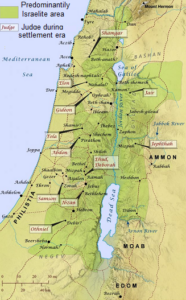
Period of Judges or Birth of Republics
By biblical narrative and also by archaeological and historical studies, the period of the end of the exodus and reunification of Israel became known as the period of the judges, however it is possible both a biblical and historical reading as the birth of a proto-republic.
and historical studies, the period of the end of the exodus and reunification of Israel became known as the period of the judges, however it is possible both a biblical and historical reading as the birth of a proto-republic.
In the final period of Moses, he manages to see Canaan in the distance, he sets up a tent a little away from Moses where the biblical narrative says: “Moses asked for the tent and pitched it far away, outside the camp, and named it Tent of Meeting. So everyone who wanted to inquire of the Lord went out to the Tent of Meeting, which was outside the camp,” and when Moses went there, the people followed him with their eyes.
According to authors (Horowitz, 2005) and (Everdell, 2000) the period from 1250 BC. until 1030 B.C. It was characterized by the political, religious and military leadership of a leader who, by divine instruction, unified and directed the tribes of Israel and could be considered an Israelite Confederation (the ancient tribes of Israel after the exodus and return to the region of Canaan), were a type of republic ruled by judges, after the death of Moses and the leadership of Joshua.
Moses had previously sent 12 spies to the territory of Canaan, among them Joshua and Kalebe, on the way back they established a military strategy where first the famous siege of Jericho took place and then they conquered the mountains Betel and Gibeon.
After the conquest of the territory, the period of the twelve judges begins, who will govern the people and lead them in battles for the maintenance of the territory, and will settle in a territory that goes from Mount Herman in the north to Mount Haloque and Negeb in the south.
In this period there were still several fights, some of the judges are known in the literature as the last Judges: Samson, Eli and Samuel, , however the account of Deborah as a judge of Israel is unique, considering the patriarchal society that lived (Judges 4-5) , the last judge was Samuel, the great prophet who chose, at the request of the people, the first two kings: Saul and David.
This historical period was marked by the activity of the Old Testament prophets: Jeremiah, Ezekiel and Daniel, who tried to correct the course and destiny of their people. At the end of this period in history, the rise of the Assyrian Empire is also recorded, but it will reach the limits of Israel going as far as Egypt, under the leadership of Ashurbanipal in 690 BC. to 627 BC, in 609 BC. the first deportation of the Hebrew to Babylon takes place, and in 598 B.C. young king Jehoiachin, king of Judah, voluntarily surrenders.
Horowitz, Maryanne Cline (2005). «Republic». New Dictionary of the History of Ideas. 5. Detroit: Charles Scribner’s Sons.
Everdell, William R (2000). The End of Kings. A History of Republics and Republicans (em inglês). Chicago: University of Chicago Press.









